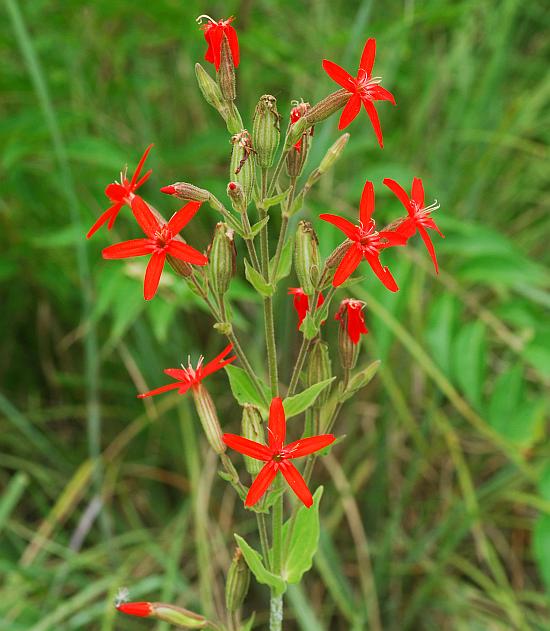Silene regia Sims
Royal Catchfly

Native
CC = 9
CW = 5
MOC = 34
© SRTurner
Silene regia SimsRoyal Catchfly | |
 |
Native CC = 9 CW = 5 MOC = 34 |
© SRTurner |
|
Family - Caryophyllaceae Habit - Perennial forb with a stout, fleshy taproot.
Stems - Erect, to 1.2 m, unbranched below the inflorescence, moderately roughened with short, stiff, downward-angled hairs toward the base and with stalked glands toward the tip, rarely glabrous or nearly so.
Leaves - Opposite, simple, sessile, decussate, usually 10-20 pairs per stem. Blades 4-14 cm long, ovate to lanceolate, tapered to rounded or somewhat cordate at the base, angled or tapered to a bluntly or sharply pointed tip, the surfaces moderately to densely roughened-hairy or rarely glabrous. Single midrib impressed adaxially, expressed abaxially.
Inflorescence - Open terminal cymes. Inflorescence divisions subtended by a pair of bracts, these resembling small leaves, with herbaceous, green margins. Pedicels and bracts densely viscid-glandular. Pedicels 5-15 mm long.
Flowers - Perfect. Sepals 17-22 mm long, the tube with 10 parallel, nonanastomosing nerves, tubular to narrowly conical at flowering, narrowed toward the base, becoming somewhat inflated and ellipsoid at fruiting, green, pale between the nerves, with stalked glands, the lobes triangular, green, bluntly pointed at the tip, the margins thin and white or reddish-tinged. Petals 5, 30-40 mm long, the expanded portion 10-16 mm long, entire or with a few fine teeth toward the tip, rarely notched at the tip (but lacking additional lobes), bright red, with a pair of small appendages on the upper surface at the base of the expanded portion. Stamens 10, 5 adnate to the base of the petals and 5 alternating with the petals, slightly exserted. Styles 3, distinct, well exserted, to 3 cm, glabrous, white with purple apices (stigmas). Ovary superior, green, glabrous, cylindric, 7-8 mm long, 2 mm in diameter, unilocular. Placentation free-central. Ovules numerous.
Fruits - Capsules 14-16 mm long, opening by usually 6 teeth, with a stalklike basal portion 3-5 mm long. Seeds 1.5-2.0 mm wide, kidney-shaped, the surface finely tuberculate, dark reddish brown.
Flowering - May - October. Habitat - Upland prairies, glades, tops of bluffs, savannas, rocky openings of upland forests, fencerows, railroads, and roadsides. Also cultivated. Origin - Native to the U.S. Lookalikes - S. virginica Other info. - This striking plant can be found in the Ozark region of Missouri, as well as in scattered locations in a few other Midwestern states. It is uncommon in most places and is threatened by habitat destruction. The plant is easily identified by its bright red flowers with sticky, tubular calyces. It differs from its lookalike S. virginica in having leafier stems and petals which are usually not notched at the tip. Both species rival any commonly cultivated plant and should be grown more often in home gardens. It is relatively easily propagated from seed and also is available for sale at most native plant nurseries in the state. Photographs taken off Hwy EE, McDonald County, MO., 8-15-03 (DETenaglia); also at Shaw Nature Reserve, Franklin County, MO, 7-4-2007, 6-18-2011, 7-22-2015, and 7-22-2020 (SRTurner). Thanks to Kathy Bildner for photo of roots, and supplying mature fruits for photographic imaging. |